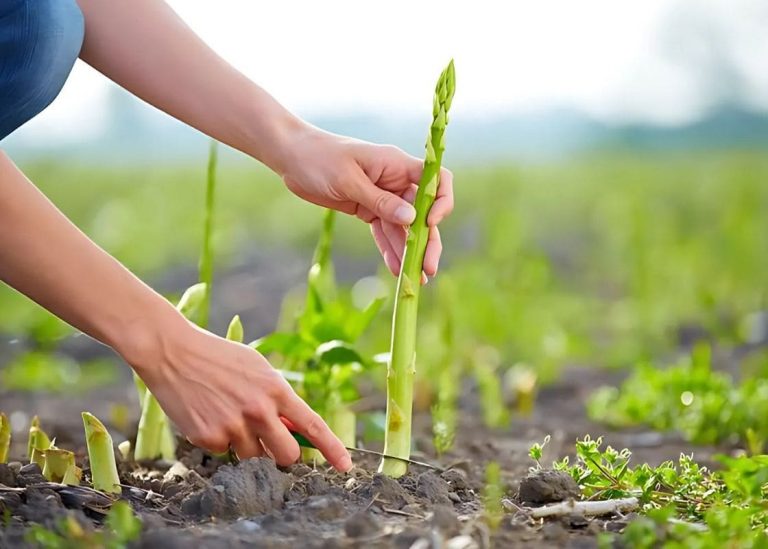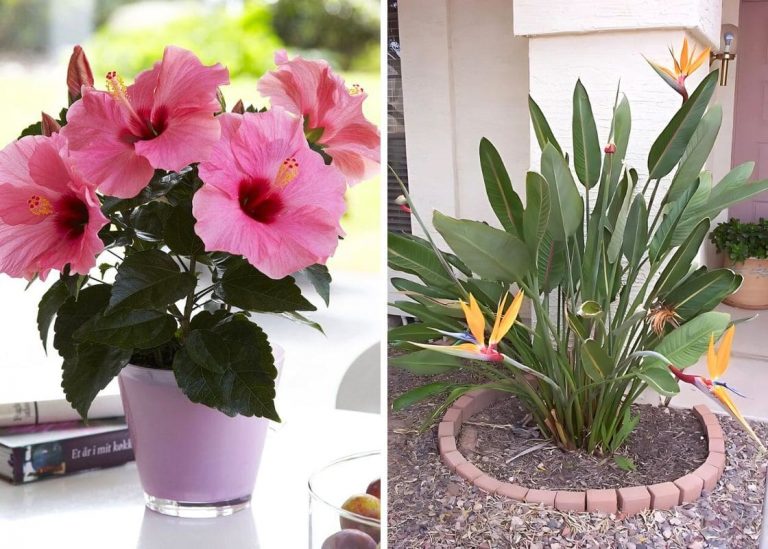Grow Potatoes in a Container: A Gardener’s Guide to a Bountiful Harvest
One spring afternoon, I looked at a little stack of seed potatoes on my kitchen counter, wondering if they had any hope. The backyard was still a soggy mess from winter rains, and my vegetable beds were too full of onions, lettuces, and a few stubborn radishes that refused to move. The idea of waiting for dry soil didn’t sit well with me. I craved the feeling of getting my hands into the dirt, of growing something hearty, something hopeful.
The old wooden barrels by the shed caught my eye—half-forgotten from last year’s herb experiments—and a thought sprouted just as quickly as those first potato eyes. Maybe, just maybe, those barrels could become miniature gardens of their own. With a bit of soil, a few good seed potatoes, and a hopeful heart, I could still bring a harvest to life, even if the garden beds weren’t ready to welcome it.
That evening, as the sun began dipping behind the hills, I pressed the cut pieces of potato deep into soft new soil. A few weeks later, soft green shoots poked out like tiny promises. By midsummer, the barrels were lush with leafy vines, and when it came time to tip one over, a treasure trove of golden, dusty potatoes tumbled out onto the tarp. No amount of store-bought produce could match the thrill of gathering those warm, earth-scented jewels with my own hands.
It’s been years now, and I still grow potatoes in containers every season—sometimes in barrels, sometimes in giant grow bags, even once in an old trash can I scrubbed clean. Each harvest feels like a quiet celebration. If you’ve ever longed for a way to grow your own food without needing a wide stretch of land, trust me—potatoes in containers might just be your next garden adventure.
Why Grow Potatoes in a Container?
Truth be told, container gardening wasn’t my grand plan. It was more like a happy accident born out of muddy shoes, waterlogged soil, and stubborn determination. Yet, I quickly found that growing potatoes this way wasn’t just convenient—it was strangely magical.
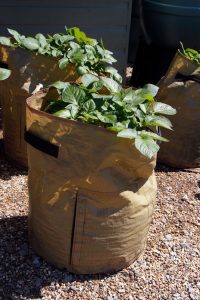
Containers let you control the soil, keep pests at bay, and skip the back-breaking digging. They make harvesting feel like a treasure hunt rather than a chore. Even my neighbor, who swore she didn’t have a green thumb, managed to pull a full basket of buttery Yukon Golds from an old fabric grow bag on her sunny balcony.
Choosing the Right Container
Not every container will do, and finding the right one feels a little like matchmaking. Potatoes need room to stretch out, dive deep, and multiply without feeling cramped. Over the seasons, I’ve experimented with everything from whiskey barrels to repurposed plastic bins.
-
Fabric Grow Bags: These lightweight wonders allow excellent drainage and airflow. They keep the roots cooler during heat waves, which my potatoes seem to love.
-
Half Whiskey Barrels: Perfect for a rustic touch. Just make sure to drill several drainage holes if they aren’t already there.
-
Large Plastic Tubs or Trash Cans: Budget-friendly and surprisingly effective, as long as you poke plenty of drainage holes at the bottom.
-
Oversized Buckets: Five-gallon buckets work in a pinch for a small harvest, but larger containers (at least 15 gallons) lead to far better yields.
Each year, I lean more toward fabric grow bags. They fold away neatly in winter and keep the soil from overheating in summer.
The Best Soil Mix for Container Potatoes
Good potatoes don’t ask for much—but heavy, compacted soil is a fast track to disappointment. I learned that lesson the hard way after a sad, stunted harvest in my early days.
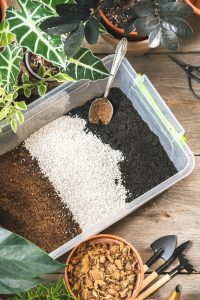
Here’s the blend that never fails me:
-
50% fluffy potting mix
-
30% rich, crumbly compost
-
20% perlite or coarse sand for extra drainage
Before planting, I like to sprinkle a handful of bone meal into the soil for extra phosphorus, giving those tubers the nutrients they need to grow plump and happy.
One neighbor, who grows gorgeous purple potatoes on her back porch, swears by adding a little bit of kelp meal, too. She says it’s like a multivitamin for roots.
Choosing the Right Potato Varieties
Some potatoes just seem born for container life. Through trial, error, and a few hilarious failures, I’ve found that early- and mid-season varieties shine brightest.
Favorites I keep coming back to:
-
Yukon Gold: Creamy, golden, and foolproof.
-
Red Pontiac: Bright red skins and cheerful yields.
-
Adirondack Blue: Deep purple spuds that are a feast for the eyes and plate.
-
Fingerling Potatoes: Perfect for small containers, with an elegant shape and rich flavor.
I always start with certified seed potatoes. Store-bought potatoes, even the organic ones, are often treated with sprout inhibitors that can mess up your plans.

A friend once tried planting grocery store spuds and ended up with exactly three shriveled, sad little tubers. Lesson learned: start right, and the harvest rewards you.
How to Plant Potatoes in a Container
Once you’ve chosen your container, soil, and potato variety, it’s time to plant. Here’s the method I’ve used for years with great success:
- If your seed potatoes are large, cut them into chunks with at least one or two “eyes” per piece. Let them dry for 24 hours before planting to prevent rot.
- Next, fill your container with about 4-6 inches of your soil mix.
- Place your seed potato pieces on top of the soil, spacing them about 6 inches apart. I typically put 3–4 seed potatoes in a 15-gallon container.
- Add another 3–4 inches of soil on top, just enough to bury the potatoes.
- Finally, give the container a deep watering, but make sure there’s good drainage.
The Hilling Process: Encouraging More Potatoes
As the plants grow, I “hill” them by adding more soil around the stems every time they reach about 6–8 inches tall. This encourages the formation of more tubers and keeps them from turning green due to sun exposure.
Here’s my hilling routine:
- Wait for the potato shoots to grow 6–8 inches.
- Add 3–4 inches of soil or straw, leaving a few inches of the plant exposed.
- Repeat every 2–3 weeks until the soil reaches the top of the container.
This technique mimics how potatoes naturally grow underground and significantly boosts the yield.
Watering and Fertilizing
Potatoes are thirsty souls but hate wet feet. I learned early on that soggy soil can drown them faster than a dry spell.
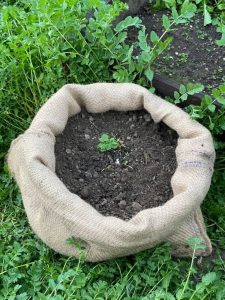
Here’s what works best:
-
Water deeply whenever the top inch feels dry.
-
Avoid shallow sprinklings—soak the container fully, then let it dry out slightly before watering again.
-
Once flowering begins, I switch from a balanced organic fertilizer to a high-potassium booster, like diluted fish emulsion.
A gardener friend once compared watering potatoes to brewing tea: slow, deep, and soulful. Rushed watering only leaves you with a bitter cup—or in this case, a thin harvest.
Harvesting Container-Grown Potatoes
The most exciting part of the process is harvesting! Depending on the variety, your potatoes will be ready in 70–100 days. You’ll know it’s time when the foliage starts to yellow and die back.
For new (baby) potatoes, I sometimes dig in carefully and harvest a few early. But when I want a full crop, I wait until the plants have completely withered.
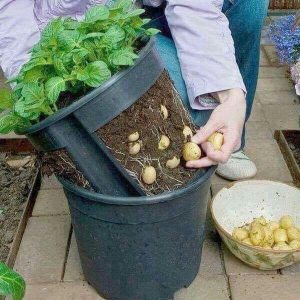
Then, the easiest way to harvest is to tip the container over onto a tarp and sift through the soil. It’s like finding hidden treasure!
Common Problems and How to Avoid Them
Of course, not every season is flawless. Mistakes happen, but they also teach you the garden’s quieter lessons.
-
Overwatering: Soggy soil rots tubers quickly. Always make sure your container drains well.
-
Poor soil: Dense, heavy soil suffocates roots. Light, fluffy mixes work best.
-
Pest invasions: Keep an eye out for aphids and flea beetles. Neem oil or insecticidal soap gently evicts them without harming your plants.
Last summer, a friend’s container turned into a soggy swamp after a few tropical storms. She drilled more drainage holes, added fresh soil, and ended up salvaging half her crop—a reminder that even setbacks can still offer something good.
Final Thoughts: The True Magic of Container Potatoes
Growing potatoes in containers isn’t just about filling a basket with food. It’s about discovering small wonders tucked into corners of our lives—about patience, hope, and the sweet reward of digging up what you nurtured quietly beneath the surface.
If your hands are itching for the soil, if your spirit longs for a simple, hopeful project, find yourself a container, some soil, and a handful of seed potatoes. Trust me—you won’t just grow food. You’ll grow joy.
Let’s get planting. There’s a hidden harvest waiting, just beneath the surface.




